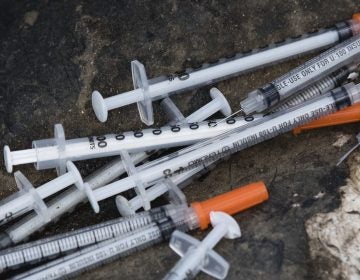New research from Philly ER doctors shows the ‘excruciating’ effect of xylazine withdrawal, and how to manage it
The powerful animal tranquilizer has started appearing in the illicit heroin and fentanyl market in recent years.
Listen 1:47
A nurse treats a man's skin wounds in a community outreach storefront in the Kensington neighborhood of Philadelphia in May. Xylazine, a powerful animal sedative that's moving through the illicit drug supply in the U.S., is causing gruesome skin wounds and scrambling longstanding methods for treating addiction and reversing overdoses. (Matt Rourke/AP)
From Philly and the Pa. suburbs to South Jersey and Delaware, what would you like WHYY News to cover? Let us know!
Since 2019, xylazine, a powerful animal tranquilizer, started appearing in street fentanyl. It has since spread throughout the United States, including in 99% of the street fentanyl in Philadelphia, according to a study last year done with the city’s health department.
While there is much that scientists do not understand about the drug’s effects and how to treat it, local research on people who use the drug shows that the painful withdrawal effects keeps them using it, and also offers a new way to manage those symptoms for long enough to get them medical care.
Last year, public health researcher Megan Reed surveyed people who use drugs in Philadelphia to study the effects of xylazine. Of the 17 people she talked to, 16 told her they hated xylazine, but cannot get off it because of the “excruciating” pain of withdrawal. In the past, they might use heroin or fentanyl every five to eight hours, but need to use xylazine much more frequently, said Reed, an assistant professor at Thomas Jefferson University.
“People are saying, ‘I have to use, even throughout the night. I wake up very, very ill and the withdrawal is nothing compared to what it was before,'” Reed said. “That’s a huge barrier to people accessing medical care because it’s very hard for somebody experiencing that agony of withdrawal to be able to make and keep a medical appointment.”
Reed said that keeps them from medical appointments for other diseases like HIV and diabetes, and from getting treated for substance use disorder.
She added there is much that researchers still don’t understand about xylazine, including how people who use it can get wounds, even if they don’t inject the drug. She recalled talking to one man who only ever snorted the drug.
“He showed me on his neck, going down, like a constellation of small wounds that are the very classic early stage xylazine wounds … maybe the size of a penny, round dark marks,” Reed said.
She said that while some people who use drugs carry wound care kits and take care of others, it’s important to train first responders on what xylazine wounds look like and how to treat them.
For the past two years, emergency room doctor Kory London, also at Thomas Jefferson University, has seen many patients suffering from the painful withdrawal symptoms of xylazine and fentanyl. He recently wrote that the patients can vomit so hard and so frequently that it damages their digestive system, and that they can have prolonged panic attacks just from a conversation.
He said that patients would use drugs, so they could go to the hospital without experiencing withdrawal. The doctors would treat them, but the treatments would not address their symptoms sufficiently. The patient would then get frustrated and leave with serious untreated medical conditions like bone and heart conditions, only to end up back in the hospital with worse outcomes.
“If somebody tells you 10 times that they’re leaving, and they understand that they could die and they still want to leave, and they’re pulling out their IV that you have to put in over and over again, after a while you just say, ‘OK, please come back when you’re ready to be treated.'”
London said that after seeing this happen again and again, he and his colleagues decided to try something different.
“Before the 21st century … there was no data about patients who had used xylazine recreationally,” he said. “The fentanyl epidemic is also relatively recent and the volumes of opioids that patients use are far and away beyond anything that we’ve dealt with in … recorded human history. ”
Now he’s working with other emergency room doctors to treat these patients with short acting opioids, which doctors already use to treat pain; and a muscle relaxing drug to counter the withdrawal from xylazine.
In a recent journal article, he reported that this combination was an effective way to keep patients in the hospital so they could complete their treatment and get a chance to heal from their wounds. Canadian doctors already use short acting opioids to treat patients on opioid withdrawal.
He said this treatment is still hotly debated, even among doctors. But he added that some interested doctors in New York City and Baltimore have gotten in touch to ask about how they could adapt it for their patients.
“Ten years ago, certainly, we would have gotten laughed out of conferences and now I’m presenting at conferences about this because I think that people are starting to realize that this is a novel condition that is going to take a different approach to truly have … important patient outcomes go well.”
The challenge with this research is that the drug supply changes constantly, with new substances being mixed in, Reed said.
“What we don’t know is whether these [new] drugs are going to become entrenched in our drug supply the way that xylazine is, or if they’re going to be blips,” Reed said. “What I’m hoping to do as we go on, is to keep doing research with people who use drugs to figure out what’s happening at any given moment in time, so we can respond very rapidly and develop interventions that work in the moment.”

Get daily updates from WHYY News!
WHYY is your source for fact-based, in-depth journalism and information. As a nonprofit organization, we rely on financial support from readers like you. Please give today.






